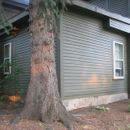How to temporarily air seal (and insulate?) a leaky mesh wall / crawl space?
I have a 1880s house in Concord, MA (zone 5A), whose porch was converted into a bedroom 30-50 yrs ago. It was a cheap job. Only the far corner is supported; the crawl space was cheaply sealed with a thin stucco skirt (just a wire mesh with concrete smeared across). Now the skirt is crumbling and cold air comes right in under our bedroom in the winter.
Until we have the money & time (probably 4-5 years off) to build a real foundation/stemwall for it, we would like to re-seal it and possibly insulate (its winter temp is 50F (rest of house: 63)).
My idea: Should I just re-apply stucco to the skirt to seal it, and cut some old polyiso sheets to lay against the skirt from the inside (taped)?
Thanks,
Kevin
GBA Detail Library
A collection of one thousand construction details organized by climate and house part











Replies
Kevin,
It's hard to answer your question. You call the construction of the skirt "a cheap job," but you also say you can't afford to fix it correctly. In other words, your repair will be just like the original work -- another cheap job.
The correct repair would be to excavate under the perimeter of the room to below the frost line -- probably at least 5 feet -- and install a concrete footing and a new concrete stem wall. This wall could be built of ICFs, which are very handy for small repair jobs like this one, and you would end up with a new airtight insulated foundation wall.
In the meantime, you can do anything you want that is cheap. You can re-stucco the wall, or you can put up taped rigid foam, or you can get a spray foam kit and install spray foam from the interior.
By the way if you dig a new footing for a full foundation wall that tree is a goner.
Opportunity cost is a bear. I'm guessing that this is not the only part of this older home that needs upgrading to improve energy performance, so while I don't disagree with Martin's description above of the 'correct' repair, there is another less expensive and less disruptive option which done correctly would be a very durable or even - dare I say it - permanent solution which might allow your restricted improvement funds to stretch further in other directions. This would be to remove the stucco and wire completely and insulate the floor from below paying special attention to air sealing, e.g. polyiso board foamed in place between the joists, then close the underside of the joists with plywood or cement board to keep the critters out. You could then re-skirt the perimeter or not, as you choose, for cosmetic reasons. Cement board would work, or even tin trailer skirt if you like the look. Obviously you would need to check the piers or posts supporting the floor to make sure they were in decent shape and make any necessary repairs while you're at it.
James,
Thanks for suggesting another workable solution.
James,
You are right about the tree. It's actually a goner for another reason as well - termites! (Until we treated recently, they had a congo line going from the tree to the house every night around 1am.) It should be gone within a month. Thanks for the suggestion -- I'll consider that. You're right about opportunity cost! We just bought the place last year after 30+ years of neglect (it was a rental), and my list of projects is too long to write down. Being an energy nerd makes my list probably double in length, as well.
Martin,
Thanks for the suggestion as well. I hadn't considered ICFs! I had it in mind to build a rock wall foundation by hand (perhaps too romantic and old-fashioned of me). I will look into ICFs though, I'm sure they would be faster and easier.
You're right, what I'm considering is the cheap way to remuddle. We have a 2yo and -0.5yo and full time jobs, plus N other projects, so time and money will be precious for a few years. I think if I can seal it and put even a little insulation there, it will be 45deg in the crawl space instead of 30, so much less of a heat sink for the bedroom floor.